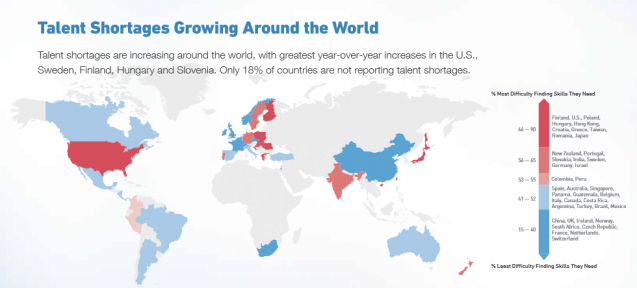According to Gartner, IT outsourcing refers to the practice of using external service providers to effectively deliver some or all IT functions required by a business. And although this approach has been around for ages, it has become a go-to service delivery model for driving business growth and gaining a competitive advantage in the era of digital transformation.
One of the reasons behind the growing IT outsourcing popularity is the increasing shortage of specialized IT skills. As global IT spendings continue to rise, so does the talent gap. In 2020, the global shortage of IT professionals amounted to a whopping 40 million. In the US, there is a strong demand for cybersecurity specialists, which is currently twice as great as the supply.
Europe too is facing a tech skills crisis. Germany that spends €2.8 billion a year on research and development activities announced there were about 82,000 vacant IT positions in 2019. Sweden expects to have 70,000 unfilled digital positions by 2022, with skills in demand including project leaders, IT developers, and testers. The same report suggests that Finland will need around 53,000 workers in the tech industry this year. The highest in-demand positions include software engineers and system analysts in this Nordic country.
Source: Manpower Group
With the race for tech talent in full-on mode, world-leading companies turn to external technology providers to fuel their digital information initiatives. But in order to reap the full benefits of IT outsourcing, a smart vendor strategy is needed. Keep reading to learn how to choose the right model and outsource effectively.
The many faces of IT outsourcing
IT outsourcing comes in different flavors — onshore, offshore, and nearshore. Let’s see what they are.
Onshore IT outsourcing
Also called domestic outsourcing, onshore refers to contracting a third-party service provider located in the same country as you for performing IT-related activities. This option is rightfully considered the most convenient as there are no language and cultural barriers, and little to no time difference.
However, onshore developers come with a high price tag, so cost benefits may be limited with this outsourcing approach.
When onshore is the right fit:
- You prioritize ease of communication and face-to-face meetings
- You prefer the convenience of the local industry network
- You are not intimidated by hefty hourly rates
For those who look for high-quality services on a budget, there are other options.
Offshore IT outsourcing
With offshore outsourcing, a development team is located in another country. Access to high-skilled talent pools, mature value delivery models, and — most importantly — lower development costs make offshoring an appealing option.
But the best deals on price come with certain risks. With a language barrier, a different cultural code, and another time zone, it may be challenging to ensure efficient communication with the team and keep the project on track.
When offshore is the right fit:
- You are looking to tap into the global pool of IT specialists
- You need to have round-the-clock operations that a team in a different time zone can provide
- You are a startup or SME with budget limitations
The next option is a trade-off between onshore and offshore outsourcing.
Nearshore IT outsourcing
Nearshore outsourcing is considered a compromise as it refers to hiring a third-party vendor from a neighboring or close-by country. This model ticks a number of boxes — competitive rates, cultural alignment, ease of access, and almost-identical time zone.
When nearshore is the right fit:
- You need a close dedicated development team available during your scheduled working hours
- Your project requires regular on-site visits and tight collaboration
- You are looking for the best price and quality balance
Nearshore IT outsourcing
How Elinext can help
At Elinext, we synergize the advantages of the best outsourcing working models, which has already made us a trusted development services vendor for our global partners.
Seamless communication is the cornerstone of any successful project. To avoid communication breakdowns and stay close to our clients, we are continuously expanding our presence, with representative offices now open in the US, Ireland, France, Germany, Singapore, and Hong Kong. This not only minimizes time zone differences but also allows our clients to have all legal and financial transactions conducted onshore, ensuring better legal protection and peace of mind.
At the same time, our partners can benefit from highly competitive rates and access to a massive pool of talent by offshoring their development activities to our dev centers in Belarus, Poland, Vietnam, with a new hub in the Czech Republic soon to be open. From mature business analysts and UI designers, to seasoned software developers and tech leads, to certified QA engineers and DevOps professionals, our clients can hand-pick the required skills and quickly ramp-up their in-house capabilities.
To become a strategic partner for our clients, we offer end-to-end development services from IT consulting and concept prototyping to production to testing and support. Depending on the size, complexity, and duration of the project, our clients can choose between different engagement models — dedicated development team, time and materials, and fixed cost. With this level of flexibility, our clients can easily find the right fit for their business goals.
Wrapping up
Outsourcing a development project is not an easy endeavor. But choosing the right model can go a long way towards achieving great business outcomes. With dozens of successfully delivered projects under its belt, Elinext can become a reliable partner throughout the entire journey. Contact us to learn more about our approach to IT outsourcing.










